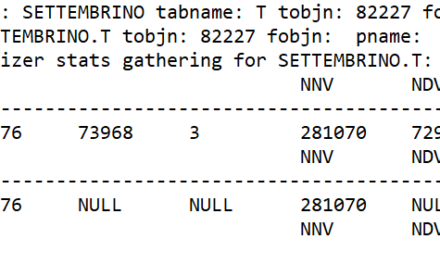* This page is the English translation of the original Italian blog post I wrote in the ICTeam blog
Recently I had to analyze an Oracle DB that showed high elapsed times on some SQL statements that “under normal conditions” were executed in parallel.
The SQL statements with a slowdown were all executed by the same application and they performed a full table scan on a large table defined with parallel_clause equal to 16.
From the point of view of the server processes used, the situation of the DB was the following:
SQL> SELECT * FROM v$px_process_sysstat; STATISTIC VALUE ------------------------------ --------- Servers In Use 248 Servers Available 8 Servers Started 150838 Servers Shutdown 150646 Servers Highwater 256 Servers Cleaned Up 0 Server Sessions 1066951 Memory Chunks Allocated 16 Memory Chunks Freed 0 Memory Chunks Current 16 Memory Chunks HWM 16 Buffers Allocated 15900444 Buffers Freed 15893892 Buffers Current 6552 Buffers HWM 9827
The DB had 248 parallel servers in use and 8 available (the parallel_max_server on the DB was set to 256). I then performed a Full Table Scan on the table (always the one defined with the parallel_clause at 16):
SELECT COUNT(*) FROM tabella;
so I looked at the v$pq_sesstat to verify that the query was run in parallel and the DOP was used:
SQL> select * from V$Pq_sesstat; STATISTIC LAST_QUERY SESSION_TOTAL ------------------------------ ---------- ------------- Queries Parallelized 1 1 DML Parallelized 0 0 DDL Parallelized 0 0 DFO Trees 1 1 Server Threads 8 0 Allocation Height 8 0 Allocation Width 1 0 Local Msgs Sent 406 406 Distr Msgs Sent 0 0 Local Msgs Recv'd 406 406 Distr Msgs Recv'd 0 0
The query was then executed in parallel but with a downgraded from parallel 16 to 8, at that time, in fact only 8 px servers were available as indicated by the V$PX_PROCESS_SYSSTAT. Under these conditions, all queries that were executed in parallel would have been penalized and therefore would have suffered a higher elapsed time.
Ok, but what does all this have to do with the SQL * Net break / reset to client event?
During the analysis I noticed a very strange situation when monitoring the sessions:
SELECT * FROM gv$session WHERE status = ‘INACTIVE’ AND event = ‘SQL*Net break/reset to client’;
I noticed that at that moment on the DB there were 15 inactive query coordinator (QC) sessions on the “SQL * Net break / reset to client” wait event, sessions all executed from the same application , some even in life from different days before, which all accessed the same table (always the one defined with parallel clause 16). At some point on the DB there were 15 * 16 (240) server processes busy doing nothing. The SQL statements were left hanging because the client had to unhook the session and the queries were orphaned but the session was not dead and therefore its parallel processes were not dead. The parallel processes existed but were doing nothing because their query coordinator (QC) session was waiting for the client to accept the reset / break. After the kill of these sessions the situation was the following:
SQL> select * from V$PX_PROCESS_SYSSTAT; STATISTIC VALUE ------------------------------------------ -------- Servers In Use 0 Servers Available 64 Servers Started 151230 Servers Shutdown 151230 Servers Highwater 256 Servers Cleaned Up 0 Server Sessions 1069615 Memory Chunks Allocated 16 Memory Chunks Freed 0 Memory Chunks Current 16 Memory Chunks HWM 16 Buffers Allocated 15937578 Buffers Freed 15937578 Buffers Current 0 Buffers HWM 9827
After killing the sessions, in rest conditions, the DB therefore kept alive only 64 server processes available (parallel_min_server) and 0 server processes in use. When the load went up, it would activate others up to a maximum of 256 (parallel_max_server).
If you ever see a DB that accuses symptoms like those just described, remember what has just been written in this post.



Commenti recenti